The Imperfect Wagnerites
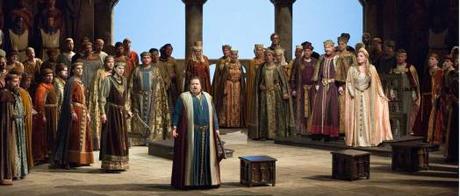 Met Tannhäuser revival (metopera.org)
Met Tannhäuser revival (metopera.org)
There was a decided distinction between George Bizet’s exotic scoring and the so-called “music of the future.” By that, of course, we mean Richard Wagner and his scorched-earth brand of music-making. Not that Wagner had anything to do with the public’s labeling of his works in this grandiose manner. As far as can be ascertained, it was strictly the fault of his supporters, who often referred to his output as “futuristic.”
By the time his 1845 opera Tannhäuser made the rounds of Paris some sixteen years later, the Dresden-born composer had upset half the European continent with his highfalutin theories about Gesamtkunstwerk, or “a total work of art.” It got so that anything that seemed daring or bold, or smacked of some kind of novelty was hooted off the stage and tagged with the “Wagnerian” label. Bizet happened to be one of those individuals who suffered this “indignity,” to quote biographer Hugh Macdonald, even though the music he composed at the time was far from what critics regarded as Wagnerian.
At the start of 1861, Bizet had already begun thinking about a new work, to be called Les Pêcheurs de Perles (aka The Pearl Fishers). As noted in my previous entry on the matter (please see the following link: https://josmarlopes.wordpress.com/2016/02/20/les-pecheurs-de-perles-and-tannhauser-part-one-casting-pearls-before-swine-and-vice-versa/), this lovely lyrical piece was given a well-received new production at the Metropolitan Opera during the 2015-2016 season. And, as heard on the broadcast of January 16, the music — while nowhere near as risk-taking as his later masterpiece Carmen would become — wasn’t even in the same league as Wagner’s earliest efforts, i.e., The Flying Dutchman, Lohengrin, the first two Ring cycle operas, and most certainly Tristan und Isolde.
In contrast, Tannhäuser and the Singing Contest at Wartburg Castle, known simply by the one-word title Tannhäuser, had made its lukewarm debut in Wagner’s hometown of Dresden. This first version was markedly different from the opera we are familiar with today: for one, there’s the “reappearance” in Act III of the goddess Venus, who was only hinted at through her first-act musical theme. This led to confusion on the part of audiences, which Wagner tried to remedy as soon as he was able.
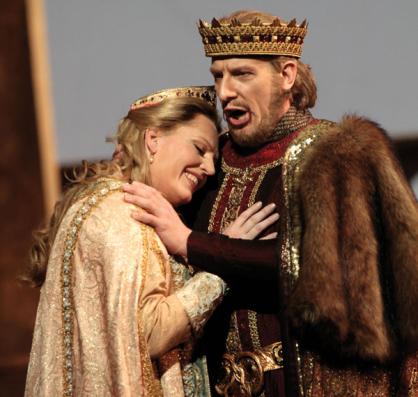
Though pleased with the overall casting at the time, Wagner was deeply troubled by the abysmal performance practices of Germany’s theaters. Too little rehearsal time, shoddy workmanship, poorly qualified singers and artisans, makeshift scenery, flimsy costumes — all of these infuriated the already intolerant composer to the degree that he set to work on a thorough restructuring of the then-current system of producing opera in the state of Saxony.
Unfortunately for Wagner, his expensive and absurdly pretentious scheme was rejected by the guardians of the state’s treasury as beyond their means or ability. This was only the beginning of the composer’s single-minded (and self-serving) ploy to obtain the best possible conditions for the future preservation of his works. Indeed, it would be years before Wagner would come into contact with his savior and benefactor, King Ludwig II of Bavaria, and the realization of his dream of erecting a theater built to his (ahem) exacting standards.
We’ll Always Have Paris
March 1861. This was the month when Tannhäuser received its infamous premiere in the French capital. At the behest of Emperor Napoleon III and Princess Pauline von Metternich, the unpopular wife of the Austrian ambassador, Wagner was invited to revise the work for the Paris Opéra, on which he pinned his hopes of conquering in the ostentatious manner of Meyerbeer, Rossini and Verdi before him.
The revival — or more accurately, a rewrite for Parisian tastes — featured an extended and chromatically tinged Bacchanale at the curtain’s rise (an extraordinary piece of music from his post-Tristan period), along with additional dialogue for Venus and Tannhäuser in Act I, as well as cuts to the Act II song contest (say goodbye to Walther von der Vogelweide’s little ditty). The part of Venus was rewritten for mezzo-soprano, and a wholesale re-orchestration of sections of the work also took shape. In addition, the opera was sung en français, which was the custom for foreign works to be presented at the Opéra.
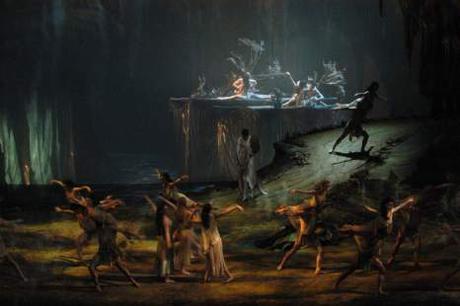
What Wagner was further pressed into doing — and that he resisted with every fiber of his being — was to insert a second act dance sequence to satisfy the more lascivious members of the notorious Jockey Club. Their favorite pastime was to arrive at the opera in time to ogle the lissome lasses of the corps de ballet as a prelude to backstage intrigue. This episode is regularly cited by writers in reference to anything and everything concerning Tannhäuser’s disastrous unveiling in Gay Paree.
Most of those gathered found the work to their liking. However, after three raucously received performances in mid-March, wherein the furious Jockey Club members whistled and booed their displeasure at the loss of their Act II divertissement, the work was withdrawn. With score in hand, Wagner retreated to neutral territory in Switzerland to mutter endless imprecations against those intolerant Frenchies and their feeble-minded theatrics.
Despite evidence that Bizet had not been present at any of the performances, the music and plot of the so-called Paris Tannhäuser managed to exert an enormous influence on him, as well as on the musical and literary community that had witnessed the event or been privy to the cause célèbre in the press.
The opera itself is one of Wagner’s most approachable. It has not been as well-served on records or CDs as it should, although there are a number of fine DVD performances. Of all his operas, this one has the highest quotient of “Greatest Hits” than any other: the Overture, the Pilgrim’s Chorus, Elisabeth’s greeting “Dich, teure Halle,” the stately Entrance of the Guests, Wolfram’s Song to the Evening Star, and Tannhäuser’s Rome Narrative are the most familiar.
The title character’s journey into the dark night of his desires is a tricky piece to pull off convincingly, but one redeemed by the twin virtues of eroticism and religiosity. The story — a struggle between the sacred and the profane, and the two female archetypes (virgin and whore) that battle for Tannhäuser’s soul — remains a time-tested morality tale that resonates not only with twenty-first century audiences, but with the sensualists of Wagner and Bizet’s day.
The question of taking responsibility for one’s actions crops up periodically throughout the lengthy and, at times, excessively preachy passages found in all three acts. For instance, who does the dual-natured Tannhäuser follow: the alluring mythological goddess Venus, who offers sensual pleasure to mortals such as himself; or the virtuous Elisabeth, whose pious nature espouses a saintly but no less viable alternative?
Tannhäuser is tempted one moment toward Dionysian passion, and the other towards Apollonian uprightness. Regardless of the direction he takes, Tannhäuser expresses discomfort in both worlds. His inability to decide between the two creates the dilemma that leads to his expulsion from the rigidly moral society he dwells in. Paradoxically, it leads to his redemption upon returning from his failed mission to seek absolution from the pope. As you can tell, this is one crazy mixed-up dude.
Bizet must have taken notice of all this when, fourteen years later (on March 3, 1875), his revolutionary Carmen had a fair to middling run at the Opéra-Comique in Paris. Not to press the Wagnerian connections too fully, one cannot fail to notice a comparable juxtaposition between the virginal peasant-girl Micaëla (soprano), who embodies innocence and homespun orthodoxy, and the voluptuous gypsy Carmen (mezzo or dramatic soprano), a fiery temptress and purveyor of free love.
No wonder Wagner’s most ardent follower (and later detractor), the philosopher Friedrich Nietzsche, preferred Carmen’s irresistible charms above all others, writing to a friend, “I almost think Carmen is the best opera there is,” and, in The Case of Wagner, praising Bizet’s music that “liberates the spirit” and “gives wing to thought.” Nietzsche had swung one way toward Wagner and then veered a hard right over to Bizet.
In actuality, both Bizet and Nietzsche were imperfect Wagnerites, as the composer himself was. Perhaps they came to the conclusion that Wagner, when writing this specific piece, was in fact contemplating his own dual nature. I’ll wager that Tannhäuser, in either the original 1845 or revised 1861 versions, was Wagner’s most autobiographical statement to date.
Old Ways vs. New Ways
This brings us back to how opera companies, with the Metropolitan Opera at the supposed vanguard, have translated the inherent duality of Tannhäuser into a creditable stage vehicle.
One of the most potent of modern-day productions was the one Peter Sellars directed for Lyric Opera of Chicago in October 1988. In this shockingly contemporary foray, the iconoclastic Mr. Sellars remade Wagner’s fallen hero into a Jimmy Swaggart-like revivalist preacher (shades of Sinclair Lewis’ Elmer Gantry), struggling with inner demons over his lust for the sexually provocative prostitute Venus, who does a formal striptease at the close.
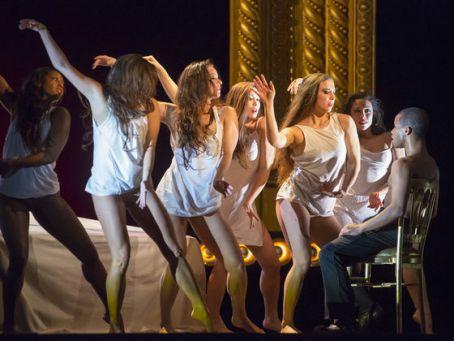
This version was also one of the first major U.S. productions to include the continuous use of overhead projections of the text, which swayed radically from the composer’s holier-than-thou, Victorian-era ramblings, much to the audience’s amusement. This may have seemed like an exaggerated attempt at American Eurotrash or an out-and-out mocking of Regietheater, but it no doubt wowed the critics and public out of their complacency. That’s to be expected when dealing with the likes of Sellars and Wagner. Moreover, it proved once and for all the universality of the composer’s themes.
No such wowing was evident from the taped Metropolitan Opera performance of October 31, 2015 (coincidentally, coming 27 years after Lyric Opera’s production), heard on the Saturday broadcast of January 23, 2016. This was a revival of another of those old, tastefully bland Otto Schenk and Günther Schneider-Siemssen diversions (this one from December 1977) that once populated the Met stage and that, at its premiere, was hailed as a winner. Almost forty years after the fact, the polish has worn off.
Mind you, there’s nothing wrong with old-style productions, or having Wagner’s operas take place in the actual settings called for (now there’s a novelty!). The problem for opera lovers is that modern theater has progressed far beyond the tried-and-true formulas of the past. That goes for those out-of-date methods once employed to tell the story. Contemporary audiences have a hard enough time relating to Wagner’s ethos let alone figuring out what all those “Ho-jo-to-hos” are about.
Now, there’s another school of thought that tends to take this notion of usurping “tradition” to the extreme. This was witnessed a few years back with Canadian Robert Lepage’s highly-stylized, platform-based recreation of Wagner’s Ring — an abject failure that took up precious playing area without adding anything substantial to our understanding of the music or plot.
In my view, if a production fails to tell the story as the composer conceived it, then it has also failed to pass muster with the public. That being the case, isn’t it better to present a piece in concert (for example, North Carolina Opera’s laudable adaptation of Tchaikovsky’s Eugene Onegin) rather than risk bashing the public over the head with a clunky, noisy, and empty-headed study of Wagner’s opus?
On the other hand, there are many more creative figures in today’s opera world than ever before. These imaginative artists can and do bring an up-to-date sensibility to old classics in ways that can be grasped — hopefully, without the trappings of fake trees and rocks, and/or painted castles and backdrops. These props were once the mainstay (and raison d’être) of many an ancient Met production, of that I can personally vouch for.
Another aspect that has changed over time is the interval between productions. The reintroduction into the Met’s repertoire of Tannhäuser, a work that has not been seen in over a decade, is most alarming. It should be noted that Wagner’s oeuvre in general has not been prominent at the Met for many years, with Tannhäuser the only representative work featured this season. Last season, it was Die Meistersinger, and before that solitary offerings of Tristan und Isolde and the aforementioned Ring. There have been no Lohengrin productions to speak of since Robert Wilson’s agonizingly slow-motion take from 2006, although Parsifal was given a milestone, utterly thought-provoking re-examination in 2013 by François Girard, a Frenchman of all people.
For this sad state of affairs, one must blame the worldwide shortage of singers capable of meeting Wagner’s demands in the amphitheater-like ambience of the Met’s auditorium, along with a general moving away from the composer’s worldview. Let’s face it: Wagner has never been the most approachable individual in terms of his bigoted ideals (printed in extraordinarily bloated essays). You might describe him as the operatic equivalent of Donald Trump if that serves the purpose.
Even with all that accumulated baggage, his music still retains a dramatic grip and theatrical power over audiences, while his Ring operas exert a stronger hold on current affairs far more than any other composer’s work. In my opinion, Wagner is one of the few farsighted musicians who championed a singular vision for the art form. Against seemingly impossible odds AND by the sheer force of personality (as reprehensible and self-promoting as it was), he managed to bring his vision to fruition via the annually recurring Bayreuth Music Festival. That’s more than most composers can lay claim to.
Memorable Met Moments
Keeping the above issues in mind, the problems of Tannhäuser and his conflicting pursuit of carnal lust and spiritual love have been portrayed by an ever-diminishing gallery of big-voiced heroic tenors.
In the Met’s pre- and postwar heyday, the Great Dane Lauritz Melchior took pride of place among the handful of artists brave enough to take up the role’s challenges. Max Lorenz, Ludwig Suthaus, Set Svanhom, Wolfgang Windgassen, René Kollo, Spas Wenkoff (in a memorable Götz Friedrich production at Bayreuth), Reiner Goldberg, James McCracken, Richard Cassilly, and Richard Versalle were also heard at various times, though not all of them at the Met. Each brought their specific vocal traits and acting requirements to the medieval Minnesinger, with the bulkily built McCracken and Cassilly looking and sounding like mirror images of each other.
With a voice like thunder, the late Canadian dramatic tenor Jon Vickers had gotten as far as studying the part. He was even scheduled to make his role debut in the Met’s 1977 production. However, he bowed out at the last minute due to his inability to reconcile the character’s amoral issues with his own strongly-held religious beliefs. Odd, since he also sang Siegmund and Tristan.
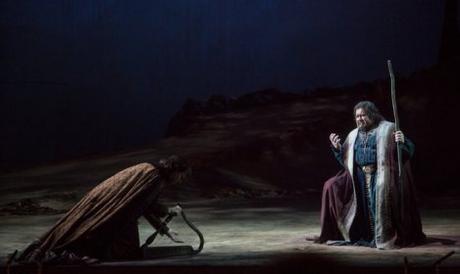
In the Saturday afternoon broadcast, the knight’s foibles were placed in the sturdy hands of an iron-lunged South African: Johan Botha. Mr. Botha galvanized audiences with his staying power and authority, in addition to the ease with which he managed the more grueling moments. A large man by any measure, with a generously endowed physique, Botha renewed one’s faith in the Met’s Wagner wing that will it be restored to full service in the foreseeable future. His previous assignment at the house was in the revival of Die Meistersinger, whereby he took on the role of Walther von Stolzing — splendidly, I might add.
His Act III “Rome Narrative,” that mournful rumination on self-loathing and the pitiable state of the character’s predicament, has not been so well sung or expertly delineated in many a season. Even more importantly, Botha’s phrasing was well-nigh perfect, with every word given its full weight and meaning. The bile and vitriol that Tannhäuser poured out at his recollection of the pope’s rejection in Rome was simply astounding. Botha traversed the high-lying tessitura of the Act I Hymn to Venus with assurance and plenty of breath to spare. Whereas previous artists tired by the end of Act II, Botha was as fresh as a daisy. He only got better as the opera progressed, which was an astonishing feat of vocal dexterity in any age, but an unqualified miracle in ours.
Indeed, both Botha and baritone Peter Mattei, as the minstrel Wolfram von Eschenbach, took home the vocal honors. Mattei, whose depiction of Amfortas in Parsifal a few seasons back set a new benchmark for how that part should be played and acted (in a word, the singer was outstanding), brought a silvery tone and virile presence to this goody-two-shoes character. He got to sing the score’s best-known tune, the lovely Song to the Evening Star. It was meltingly delivered in as close to bel canto style as possible. In fact, this opera was the closest Wagner ever got to imitating Bellini. If you don’t believe me, check out the intricate ensemble that comes near the close of Act II.
Mattei’s character is in love with the heroine, Elisabeth. He and the other Minnesingers (“troubadour” in German) take part in a contest to see who can best capture the sentiment in song. All hell breaks loose when Tannhäuser decides to sing the praises of Venus before the astonished assemblage. They are about to come to blows, but for Elisabeth’s intervention. As penance, he must go to Rome to seek the pope’s forgiveness.
Mr. Mattei was closely followed by Günther Groissböck as the Landgrave Hermann. His rolling bass virtually wiped the floor clean of contenders in this underappreciated assignment. Normally, the Landgrave halts the show (and the proceedings) with his lugubrious sermon on the virtues of purest love. Not here, thank goodness. Again, excellent enunciation was the rule along with a rock-solid technique. What a magnificent Hagen this artist would make! Are you listening Met management?
The two women, mezzo Michelle DeYoung as Venus and soprano Eva-Maria Westbroeck as Elisabeth, were less impressive in their individual assignments. Both singers have large, well modulated voices, and both looked positively stunning in costume. They also sounded too much like one another, which is not necessarily a bad thing. According to Wagner, this was how he intended the roles to be seen: as different sides of the female psyche. There have been instances in the past of the same singer taking on both parts, not only on LP — I’m thinking of Birgit Nilsson in an old Deutsche Grammophon recording with Windgassen — but on the stage as well, with Dame Gwyneth Jones in a DVD of the Friedrich Tannhäuser.
Ailing Met maestro James Levine presided on the podium, and he led a model performance from his specially constructed elevator-chair, with the Met Opera Chorus dazzling as always in Wagner’s fabulous choral writing. Pacing is the primary component for any successful work by this composer, and Levine was fully up to the task.
Surely a revival, or even better, a new production of the same composer’s Lohengrin would be in the offing. Only this time, make certain that audience favorite Jonas Kaufmann, who triumphed in Europe in several outrageous adaptations of Wagner’s romantic opera and who recently opted out of the Met’s new Richard Eyre production of Puccini’s Manon Lescaut, is nursed back to health. He is sorely missed in this repertoire!
In his absence, I’d take the large economy-sized Johan Botha any time, any day. With a Tannhäuser like that, even Lauritz Melchior would be pleased.
Copyright © 2016 by Josmar F. Lopes

